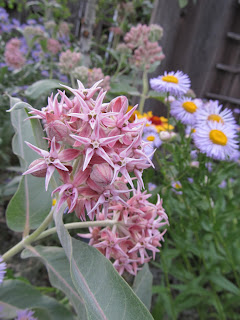Making your own suet for a backyard suet feeder is a fun project for the fall. Suet, by the way, is animal fat, and it is a popular winter bird food. You can buy suet for bird feeders in the store, and often they have berries or insects or nuts mixed in. "Suet" technically refers to the animal product (fat) but in the context of bird feeding, it refers to the fat plus whatever else is in there. More on fat later.
With the holiday season coming, homemade suet combined with an easy to make suet feeder is a great holioday gift for your bird-loving friends, or a holiday gift to the birds in your garden. Plus, it is great way to use an otherwise unused product (tallow aka fat).
I am not a huge fan of bird feeders (click here for some thoughts on why), but I do set out a few suet feeders in the winter. The main reason I don't like bird feeders is that they are not really effective if your goal is to get a lot of diversity. Of the 60 species of birds that use our garden, less than 20% use the feeders. Birds come to the garden for the structure, for the native plants and for insects, seeds, and berries, not the bird feeders. However in the winter, the birds we are likely to encounter in the garden eat suet and need the high calories and fat it provides, and winter is an important time to consider your wildlife garden. Suet is a natural food that in the wild (before backyard feeders were invented) comes from animal carcasses- either as a result of natural death (old age),winter kill or predators. This is a seasonally importatnt source of food for a variety of birds ranging from little nuthatches and chickadees to ravens and magpies (and bald eagles, though we don't get them in our garden).
My favorite suet feeder is a rib cage. It might look odd, but the birds recognize it! Click here for more information)
Making your own suet is easy, and free, especially if your hunt or have access to suet. A word about suet- there are many kinds of animal fat, and here I use the term "suet" to describe tallow, or the thick, chalky, white fat found just below the hide on an animal that provides them with insulation. This is the least palatable of the fats and is discarded when butchering game. Tallow covers the back and hind quarters and the rump of animals. This is different from other types of fat, and is not "trim" which contains meat that you might get from a butcher to mix in with ground meat for burger.
If you butcher your own animals, you know what this is and you have a source for it, but even if you don't, or don't have a friend that hunts, you can still get this from the butcher (it is really cheap). Just make sure to explain what you are looking for and what you are using it for. You don't want to get anything that has meat on it.
Anyway, back to the bird food. Below are all the ingredients we used today, and I got these from a quick lap around our garden- blue elderberries (Sambucus cerulea), rose hips from Wood's rose (Rosa woodsii), and mountain ash berries (Sorbus scoulina). All native plants.
This brings up another reason I don't like conventional bird foods and mixes you get in the store: they contain plants that are either not suited to the native birds you might be trying to attract or there are weed seeds in the mix. By using native plants you are guaranteed weeds won't be spread around. Rose hips and elderberries are some of ther last berries to get eaten- birds seem to rely on freezing to make them more palatable.
If you don't have any berries or seeds in your garden, this is a great opportunity to get outside and look for what is available in your area. And while to are out there, see if you can find a log for a suet feeder (see below).
This is what the tallow looks like.
The next step is optional. I like to run the tallow through a grinder through a coarse grinding plate. This breaks it down to uniform pieces and makes the rendering go quicker and smoother.
Here is the coarsely ground tallow.
The key to rendering the tallow is to melt it over a low heat. You just want to melt the fat, do not boil it or cook it. Stir it frequently, and, as is liquefies, and add more. Once it is all rendered you could skim the top to get out any dirt, meat or cartilage, or if you really want, you could run it through a sieve, strainer or cheese cloth. I don't think it is really necessary, though.
Add the nuts or berries to the rendered tallow and mix it thoroughly. Again, you don't need to cook it, just make sure it is mixed and smooth. There are many suet recipes that suggest adding flour or corn starch, but I don't think it is really necessary.
Once it is all mixed, ladle into a form that best fits you suet feeder. My favorite suet feeder (apart from a rib cage) is really simple to make and is really enjoyed by the birds. Click here for more information on how to build it, but all it is is a log with some 1-2" deep holes drilled into it.
Because of these cavities I like to put the suet into ice cube trays. Each hole in the suet feeder is about the size of an ice cube, so it makes the kind of messy job of filling the feeder, easy.
Set the suet outside to cool , and then fill up and install your suet feeder.






















































